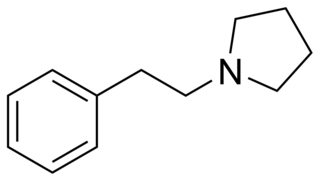
D-norpseudoephedrine, also known as cathine and (+)-norpseudoephedrine, is a psychoactive drug of the phenethylamine and amphetamine chemical classes which acts as a stimulant. Along with cathinone, it is found naturally in Catha edulis (khat), and contributes to its overall effects. It has approximately 7-10% the potency of amphetamine.
A dopamine reuptake inhibitor (DRI) is a class of drug which acts as a reuptake inhibitor of the monoamine neurotransmitter dopamine by blocking the action of the dopamine transporter (DAT). Reuptake inhibition is achieved when extracellular dopamine not absorbed by the postsynaptic neuron is blocked from re-entering the presynaptic neuron. This results in increased extracellular concentrations of dopamine and increase in dopaminergic neurotransmission.

Ethylmorphine is an opioid analgesic and antitussive.

Phenmetrazine is a stimulant drug first synthesized in 1952 and originally used as an appetite suppressant, but withdrawn from the market in the 1980s due to widespread abuse. It was initially replaced by its analogue phendimetrazine which functions as a prodrug to phenmetrazine, but now it is rarely prescribed, due to concerns of abuse and addiction. Chemically, phenmetrazine is a substituted amphetamine containing a morpholine ring.

Pinazepam is a benzodiazepine drug. It possesses anxiolytic, anticonvulsant, sedative and skeletal muscle relaxant properties.

Aminorex is a weight loss (anorectic) stimulant drug. It was withdrawn from the market after it was found to cause pulmonary hypertension. In the U.S., it is an illegal Schedule I drug, meaning it has high abuse potential, no accepted medical use, and a poor safety profile.

Lefetamine (Santenol) is a drug which is a stimulant and also an analgesic with effects comparable to codeine.

Methylenedioxypyrovalerone (MDPV) is a stimulant of the cathinone class that acts as a norepinephrine–dopamine reuptake inhibitor (NDRI). It was first developed in the 1960s by a team at Boehringer Ingelheim. Its activity at the dopamine transporter is six times stronger than at the norepinephrine transporter and it is virtually inactive at the serotonin transporter. MDPV remained an obscure stimulant until around 2004 when it was reportedly sold as a designer drug. In the US, products containing MDPV and labeled as bath salts were sold as recreational drugs in gas stations, similar to the marketing for Spice and K2 as incense, until it was banned in 2011.

Pyrovalerone is a psychoactive drug with stimulant effects via acting as a norepinephrine-dopamine reuptake inhibitor (NDRI), and is used for the clinical treatment of chronic fatigue or lethargy and as an anorectic or appetite suppressant for weight loss purposes. It was developed in the late 1960s and has since been used in France and several other European countries, and although pyrovalerone is still occasionally prescribed, it is used infrequently due to problems with abuse and dependence. It is closely related on a structural level to a number of other stimulants, such as α-PVP, MDPV and prolintane.

α-Pyrrolidinopropiophenone (α-PPP), is a stimulant drug. It is similar in structure to the appetite suppressant diethylpropion and has analogous effects in animals. Little is known about this compound, but it has been detected by laboratories in Germany as an ingredient in "ecstasy" tablets seized by law enforcement authorities. This drug has been found to produce stimulant effects in animals and presumably also produces these effects in humans, based on the context in which it has been found.

Chlorphentermine is a serotonergic appetite suppressant of the amphetamine family. Developed in 1962, it is the 4-chloro derivative of the better known appetite suppressant phentermine, which is still in current use.

Mesocarb is a drug that is currently being developed for Parkinson's disease.

Mefenorex is a stimulant drug which was used as an appetite suppressant. It is an amphetamine derivative which was developed in the 1970s and used for the treatment of obesity. Mefenorex produces amphetamine as a metabolite, and has been withdrawn in many countries despite having only mild stimulant effects and relatively little abuse potential.

4'-Methoxy-α-pyrrolidinopropiophenone (MOPPP) is a stimulant designer drug of the pyrrolidinophenone class. It has the potential to produce euphoria, an effect shared with other classical stimulants.

α-Pyrrolidinopentiophenone is a synthetic stimulant of the cathinone class developed in the 1960s that has been sold as a designer drug. Colloquially, it is sometimes called flakka. α-PVP is chemically related to pyrovalerone and is the ketone analog of prolintane.

Naphyrone, also known as O-2482 and naphthylpyrovalerone, is a substituted cathinone drug derived from pyrovalerone that acts as a triple reuptake inhibitor, producing stimulant effects and has been reported as a novel designer drug. No safety or toxicity data is available on the drug.

1-(2-Phenylethyl)pyrrolidine (PEP) is a chemical compound. It is an analogue of 2-phenylethylamine where the amine has been replaced by a pyrrolidine ring.
Bath salts are a group of recreational designer drugs. The name derives from instances in which the drugs were disguised as bath salts. The white powder, granules, or crystals often resemble Epsom salts, but differ chemically. The drugs' packaging often states "not for human consumption" in an attempt to circumvent drug prohibition laws. Additionally, they may be mislabeled as plant food, powdered cleaner, and other such products.

α-Pyrrolidinohexiophenone is a synthetic stimulant drug of the cathinone class developed in the 1960s which has been reported as a novel designer drug.

MDPHP (3',4'-Methylenedioxy-α-pyrrolidinohexiophenone) is a stimulant of the cathinone class originally developed in the 1960s, which has been reported as a novel designer drug. In the UK its slang name is monkey dust. It is closely related to the potent stimulant MDPV though with slightly milder effects, and has been used as an alternative in some countries following the banning of MDPV.



















